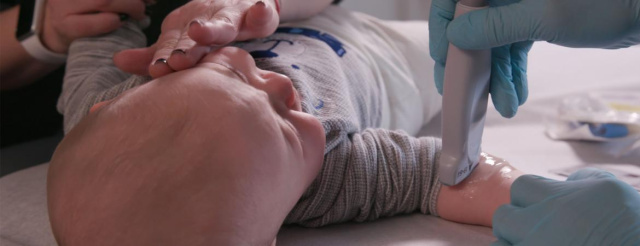
More than five million central venous catheter (CVC) lines are placed in hospitals each year, making it one of the most common invasive emergency room procedures. Although NICE guidelines for ultrasound-guided placement of central venous lines in adults and children were first issued in the UK in October 2002, Dr. James Bennett, Consultant Anesthetist at Birmingham Children's Hospital, describes how the debate has since moved on from whether ultrasound should be used for vascular access, to what other information and safety assurances it can provide, especially in pediatrics.
“The transplant unit at Birmingham Children’s Hospital – now part of Birmingham Women’s and Children’s NHS Foundation Trust – carries out around 35 liver and 12 kidney transplants a year, plus a smaller number of intestinal transplants, one of only two centers in the UK to perform this procedure. Children with liver disease are an especially challenging group when it comes to vascular access and those with bowel conditions particularly so; many have lost a significant part of their intestine and have been fed intravenously with parenteral nutrition, they may have lost a number of central veins, either as a consequence of the insertion technique previously used, or simply from the central venous catheters being in place for an extended period of time.
“Over the last 15 years, point-of-care (POC) ultrasound has become an essential tool to quickly and safely aid anesthetists, as well as the array of professionals from different clinical backgrounds who are now regularly inserting lines. However, for the more specialized area of pediatrics, and specifically for long-term venous access, for example Hickman lines in children with cancer, formalized training programmers are something of a challenge.
“For instance, while there is currently a module for central venous access in the syllabus for anesthetists in training, there is little addressing long-term vascular access. The safety of central venous access is a matter of concern for the Association of Anesthetists and, last year it produced a document providing guidance for vascular access.
“In the meantime, at the Birmingham Children’s Hospital, POC ultrasound guidance is now always used for central venous catheter insertion, and increasingly for arterial lines and difficult peripheral venous access. Ultrasound guidance is also establishing a valuable role in regional anesthesia, for example TAP (transverse abdominis plane) blocks to improve analgesia following surgery in children.
“Ultrasound guidance is the tool of choice particularly for the vascular access team, whose practice includes many challenging cases. At present, there are three portable systems used in the department which, while not the newest instruments on the market, provide the imaging quality and reliability that is required. It is also useful that they are small and mobile so can be moved easily, and maneuvered into place around the many pieces of equipment that typically populate operating theatres.
“In reality, most vascular insertions are remarkably easy using real-time ultrasound guidance; indeed accessing the vein is rarely a time limiting factor, unless it’s a particularly difficult case. The key advantage of course is safety; allowing quick identification of a suitable vessel and then guiding the cannulating needle into it, while avoiding other structures. Consequently most of these procedures are performed first pass without complication. It becomes a purely technical exercise, ‘it's just a needle into a vein, and it's as easy as that’.
“The more advanced skills are saved up for the difficult cases when POC ultrasound really comes into its own. Ultrasound can demonstrate blocked or narrow veins, as well as imaging collateral and aberrant vessels. It often saves time because you can clearly image a blocked vein and choose a different access site. The use of Doppler ultrasound also allows assessment of flow within the vessels.
“POC ultrasound does more for vascular access than just guiding a needle into a vein; you quickly gain the information about the vascular anatomy necessary to safely place a line.”


